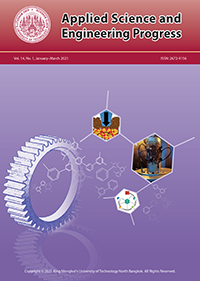Ethanol Extraction of Active Ingredients and Antioxidants from Germinated Sangyod Rice
Main Article Content
Abstract
Sangyod rice is a special red rice variety, originally planted in Pattalung province of Thailand. This type of rice is high in nutrients and antioxidants. This research aimed to produce a rice extract by solvent extraction of germinated Sangyod rice. For the extraction, ethanol at the concentrations 0, 50, or 95% (v/v) was used. Various extraction times and rice-to-solvent ratios, as well as solvent reuse and recovery were studied. The results show that the extract from germinated Sangyod rice has higher TPC, TFC, and GABA contents and higher antioxidant activity than not germinated or Riceberry rice. An 0.5 h extraction time with rice-tosolvent ratio 1:15 (g/mL) were optimal for extracting germinated Sangyod rice. The 50% ethanol solvent gave the highest TPC, TFC, GABA and DPPH antioxidant activities, at 1,627.00 ± 53.08 mg GAE/100 g rice, 559.50 ± 17.06 mg QE/100 g rice, 9.97 ± 0.17 mg GABA/100 g rice, and 0.16 ± 0.01 mg/mL, respectively. Regarding stability of the rice serum, temperature affected stability of the extracts. The results of this study can provide new opportunities to promote Sangyod rice to farmers and add value to rice products. The extract has potential as an active ingredient in cosmetics.
Article Details
References
[2] S. H. Oh, J. R. Soh, and Y. S. Ch, “Germinated brown rice extract shows a nutraceutical effect in the recovery of chronic alcohol-related symptoms,” Journal of Medicinal Food, vol. 6, pp. 115–121, 2003.
[3] C. Dong-Hwa and L. Seung-Taik, “Germinated brown rice and its bio-functional compounds,” Food Chemistry, vol. 196, pp. 259–271, 2016.
[4] N. Komatsuzaki, K. Tsukahara, H. Toyoshima, T. Suzuki, N. Shimizu, and T. Kimura, “Effect of soaking and gaseous treatment on GABA content in germinated brown rice,” Journal of Food Engineering, vol. 78, pp. 556–560, 2007.
[5] H. Ti, R. Zhang, M. Zhang, Q. Li, Z. Wei, Y. Zhang, X. Tang, Y. Deng, L. Liu, and Y. Ma, “Dynamic changes in the free and bound phenolic compounds and antioxidant activity of brown rice at different germination stages,” Food Chemistry, vol. 161, pp. 337–344, 2014.
[6] W. Vongsudin, P. Ratthanatham, N. Laohakunjit, and O. Kerdchoechuen, “Change of bioactive compounds in germinated rice,” Journal of Agricultural Science, vol. 43, pp. 553–556, 2012.
[7] X. Cong-Cong, W. Bing, P. Yi-Qiong, T. Jian-Sheng, and Z. Tong, “Advances in extraction and analysis of phenolic compounds from plant materials,” Journal of Natural Medicines, vol. 15, pp. 721–731, 2017.
[8] Z. Hu, X. Tang, J. Liu, Z. Zhu, and S. Shao, “Effect of parboiling on phytochemical content, antioxidant activity and physicochemical properties of germinated red rice,” Food Chemistry, vol. 214, pp. 285–292, 2016.
[9] S. Inchue, P. Pornchaloempong, and W. Narkrugsa, “Effect of drying methods on chemical composition, color and antioxidant properties of Thai red curry powder,” Kasetsart Journal (Natural Science), vol. 44, pp. 142–151, 2010.
[10] D. Karladeea and S. Suriyonga, “Aminobutyric acid (GABA) content in different varieties of brown rice during germination,” ScienceAsia, vol. 38, pp. 13–17, 2012.
[11] J. Numchok, S. Pasuk, and P. Thakonpakdee, “Efficiency of Feronia limonia Swingle branch crude extract as antioxidant,” in Proceedings of the 5th Rajamangala University of Technology National Conference, 2012, pp. 251–260.
[12] K. Phattayakorn, P. Pajanyor, S. Wongtecha, A. Prommakool, and W. Saveboworn, “Effect of germination on total phenolic content and antioxidant properties of ‘Hang’ rice,” International Food Research Journal, vol. 23, no. 1, pp. 406–409, 2016.
[13] L. N. Thu Thao, D. T. Kim Thoa, L. Phuoc Thang, T. T. Ut Xi, D. Sao Mai, and N. T. Ngoc Tram, “Effect of ethanol on the anthocyanin extraction from the purple rice of Vietnam,” Journal of Food and Nutrition Sciences, vol. 3, pp. 45–48, 2015.
[14] K. K. Chew, M. Z. Khoo, S. Y. Ng, Y. Y. Thoo, W. M. Wan, and C. W. Ho, “Effect of ethanol concentration, extraction time and extraction temperature on the recovery of phenolic compounds and antioxidant capacity of Orthosiphon stamineus extracts,” International Food Research Journal, vol. 18, pp. 1427–1435, 2012.
[15] R. Sawaddiwong, “Germinated brown rice of indigenous southern Thai rice cultivars: Germinated condition and antioxidant properties,” M.S. thesis, Faculty of Food Science and Technology, Prince of Songkla University, Thailand, 2009.
[16] W. Pukdee, N. Kumar, P. Chaiwut, and T. Sripisut, “Development of riceberry extract for antioxidant activity,” in Proceedings MFUIC & KTCM, 2016, vol. 18, pp. 139–146.
[17] J. Sutharut and J. Sudarat, “Total anthocyanin content antioxidant activity of germinated colored rice,” International Food Research Journal, vol. 19, pp. 215–221, 2012.
[18] A. Z. Mercadante and F. O. Bobbi, “Anthocyanins in foods: Occurrence and physicochemical properties,” in Food Colorants: Chemical and Functional Properties, Florida: CRC Press, 2008, pp. 241–276.
[19] H. Masaki, T. Atsumi, and H. Sakurai, “Protective activity of hamamelitannin on cell damage induced by superoxide anion radicals in murine dermal fibroblasts,” Biological and Pharmaceutical Bulletin, vol. 18, pp. 59–63, 1995.
[20] K. Mori, N. Goto-Yamamoto, M. Kitayama, and K. Hashizume, “Loss of anthocyanin in redwine grape under high temperature,” Journal of Experimental Botany, vol. 58, no. 8, pp. 1935– 1945, 2007.


